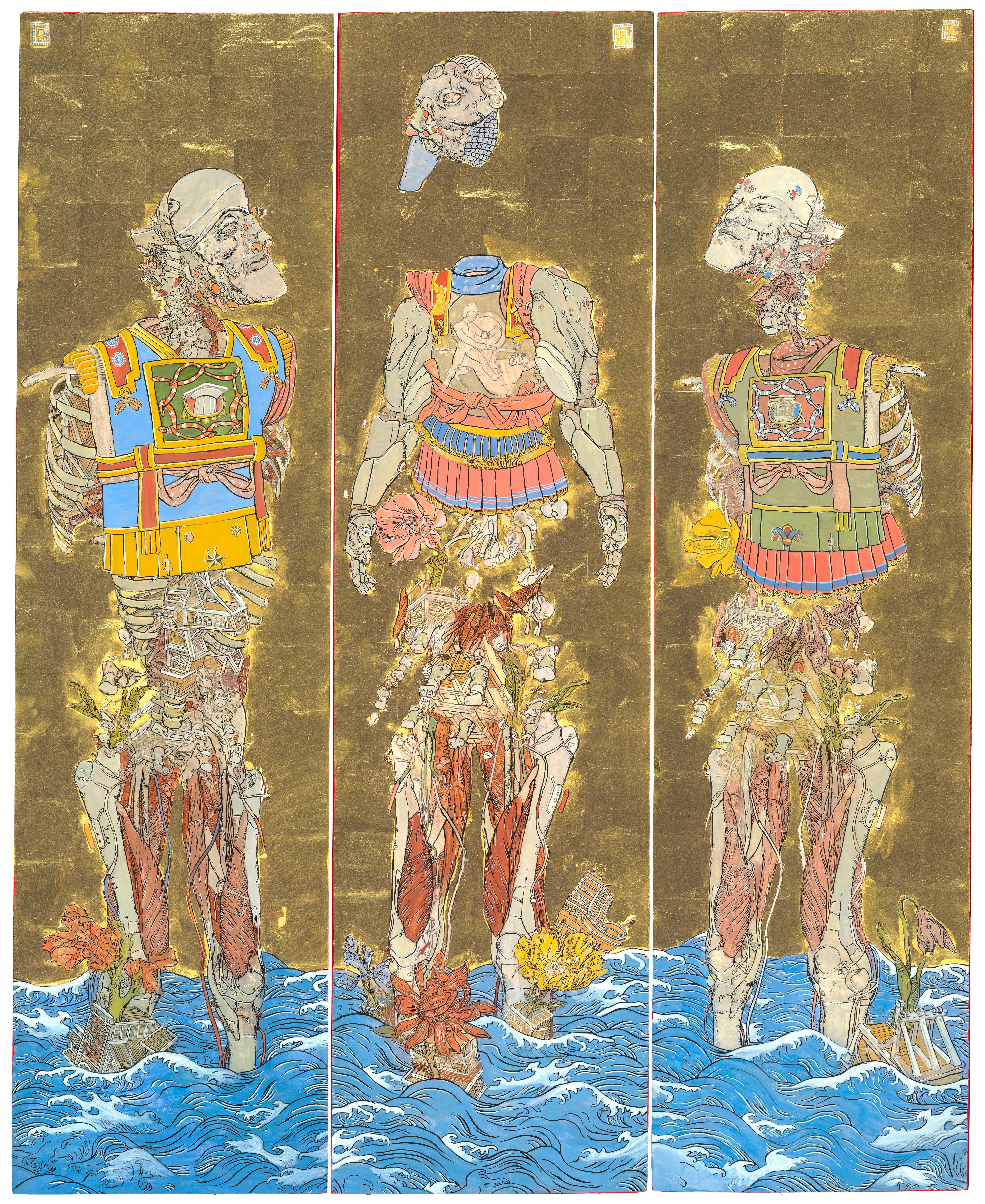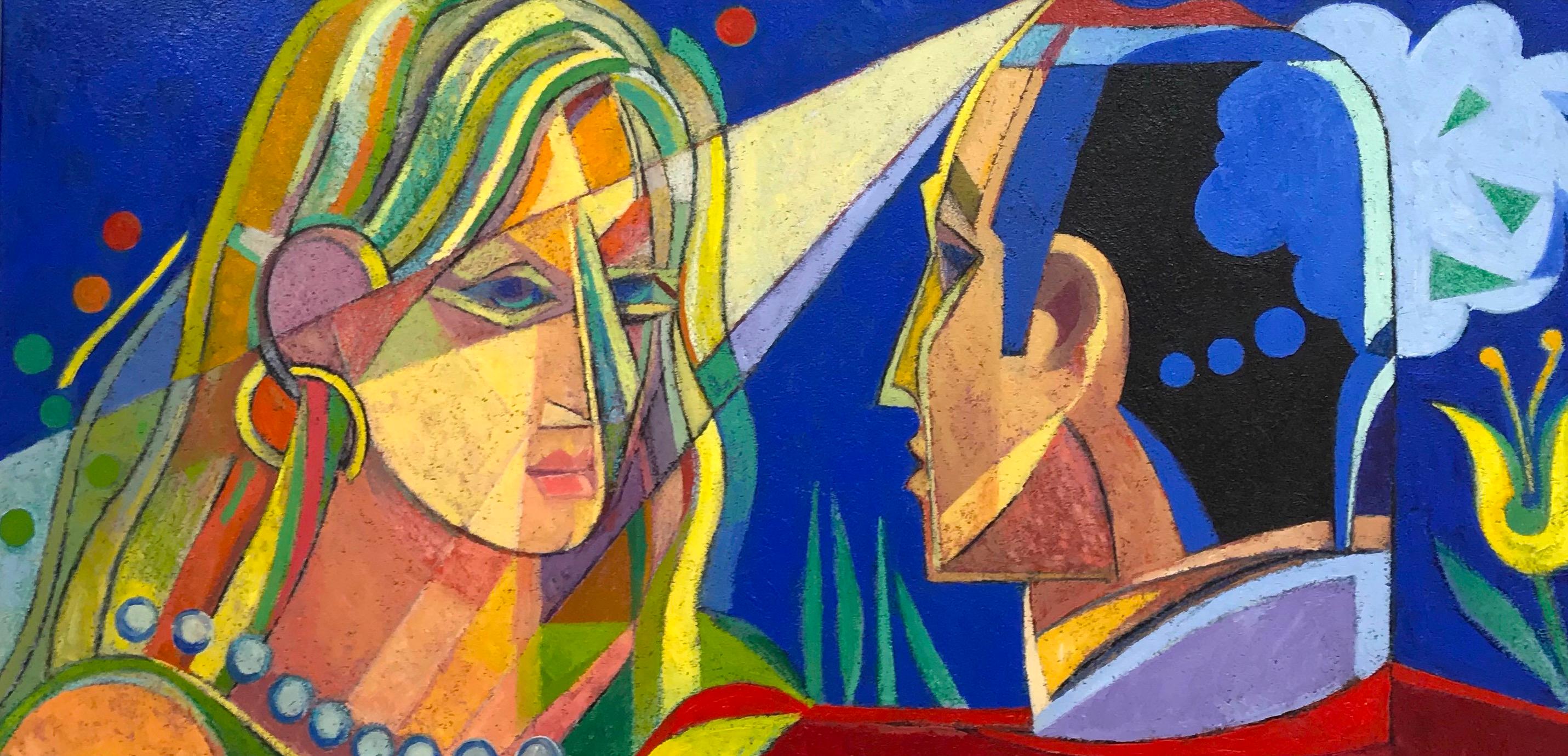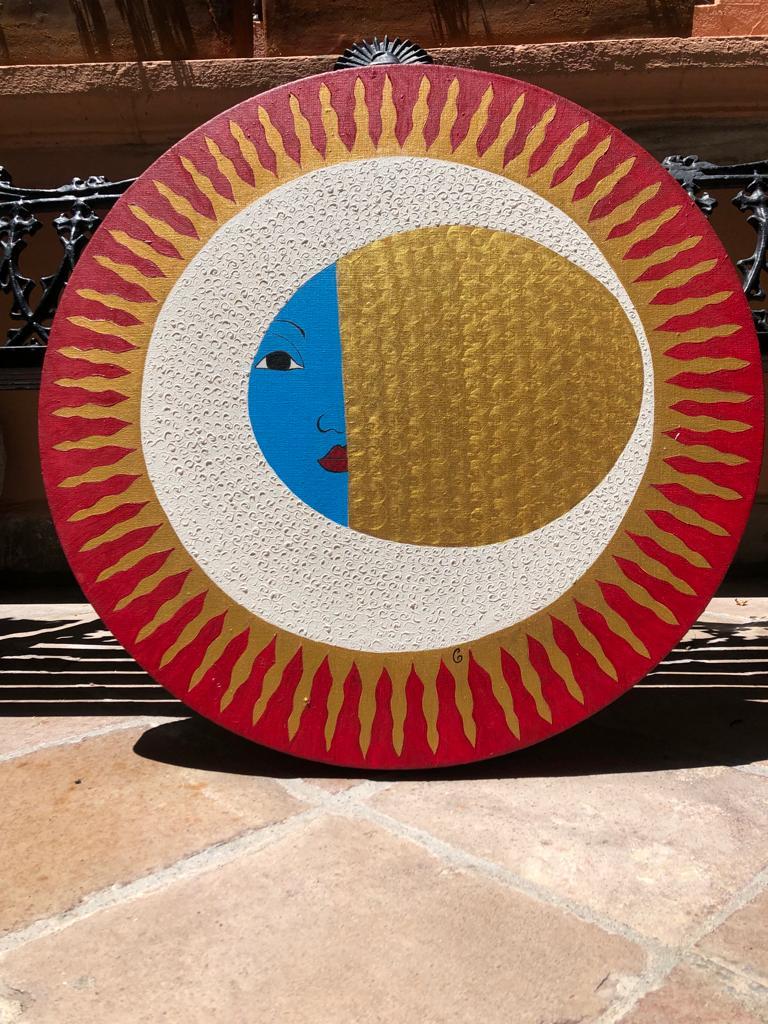Items Similar to "Centurion, " 1960s Modern Abstract Painting
Want more images or videos?
Request additional images or videos from the seller
1 of 13
Stanley Bate"Centurion, " 1960s Modern Abstract PaintingCirca 1960
Circa 1960
About the Item
This vertical format abstract painting by Modernist artist Stanley Bate measures at 26" x 50" framed. The original gold-hued floater frame pulls out the vibrant and warm pops of yellow and red in this deep charcoal palette. At the center of the composition, it appears as if the bright pops of color almost begin to take shape as a highly abstract figure. The artist's signature can be found on the bottom right-hand side of the canvas. Arrives ready to hang.
Stanley Bate was born on March 26, 1903 in Nashville, Tennessee. The Bates were an established Tennessee family, in fact, Henry’s brother William Bate was the governor of Tennessee from 1883-1887 and a United States Senator from 1887-1905. Stanley studied art at the Watkins Institute in Nashville.
In the 1920’s Bate moved to New York City to study at the Art Students League under Frederick Bridgman. He soon landed a job with Encyclopedia Britannica, and from 1927-1929 served as art editor. From 1929 until his death in 1972, Stanley was a self-employed artist. He taught art classes at both the Art Students League and the Albany Institute of History and Art and brought in extra income by making illustrations for magazines such as “Outdoor Life” and “Popular Science”.
On January 27, 1934 Stanley married Emilie Rossel. Emilie had emigrated from Switzerland to New York in 1923. She found work as a governess to Alfred Vanderbilt and later as an executive secretary for Wall Street investment brokers Kahn, Loeb and Co. Emilie met Stanley in New York in the early 1930’s when she attended one of his art exhibitions with a friend. The couple, who had no children, lived on 34th Street in Manhattan. During this period, Bate was producing and exhibiting his art and joined several artists groups. Stanley and Emilie became part of the New York art scene, dining weekly at the Society of Illustrators Clubhouse.
Stanley Bate’s time in New York was pivotal in the formation of his painting style. He lived in New York during the inception of one of the most important Modern Art movements, one that helped New York replace Paris as the center of avant-garde art. This movement, which was called the New York School of artists, was later known as Abstract Expressionism. It was comprised of a loosely associated group of vanguard artists working in New York City during the 1940s and 1950s. The New York School was not defined by a specific style, but instead reflected a fusion of European Modernism and American social relevancy that was depicted in many individual styles. Influences of Surrealism, Cubism, and Modernism can be found in their work, along with an interest in experimenting with non-traditional materials and methods. American art was in the forefront of international avant-garde for the first time.
Stanley Bate was undoubtedly exposed to the varied styles and techniques that were emerging during the formative years of the New York School. Mark Rothko and Robert Motherwell were formulating their versions of color field paintings. Joseph Cornell was experimenting with assemblages, collage and the use of different types of textured paints. Jackson Pollock was adhering objects such as buttons and coins into his early works, while Louise Nevelson was using found objects. Helen Frankenthaler added sand to her early paintings. The New York School artists were undermining traditional fine art by using mixed media and non-traditional methods.
Stanley Bate absorbed these varied influences and soon his early realistic landscapes and still-lifes were replaced with something entirely new. The influence of Cubism, notably the flat shallow space of the picture plane, is obvious in many of Bate’s paintings. Surrealism is evident in Bate’s use of subjects from myth, primitive art and antiquity, along with the Automatism-like line work in his more linear images. The unfettered experimentation of the New York School is everywhere in Stanley Bate’s work. We see nods to color field, collage, the mixing of textures into paint, mixed media, the inclusion of found objects and thick, luscious impasto.
Bate was prolific and experimented in various media including oil, watercolor, lithography, silk screen, wood cut, drawing, collage, ceramics and sculpture. Bate is considered a true Modernist. His work is largely abstract, but sometimes figures and buildings are discernable. He frequently mixed paint, sand and glue together to achieve a textured surface, and then scraped and scratched through this layer to expose some of the underpainting below. His sculpture, which is often whimsical, also reflects the non-traditional methods of the New York School. Bate pioneered the use of enamel and copper in his work. The sculptures are not carved or modeled as was done in the past, but instead are built using mixed media and new materials.
In addition to the New York School influence, many of Bate’s works exhibit a strong connection to the Spanish school, especially the work of Antonio Tapies and Modesto Cuixart. These artists were both part of an avant-garde group known as Art Informel, the Spanish equivalent of Abstract Expressionism. These artists likewise worked in mixed media and introduced objects and texture into their work. Many of Bate’s subjects and titles relate to Spanish locations and words. It is likely that Stanley spent time in Spain and found inspiration there.
By the early 1940s, Stanley and Emilie had started spending weekends in a barn they purchased in Craryville, New York, a few hours north of Manhattan. The barn had no electricity or plumbing, but when the Bates eventually decided to leave New York and live full time in Craryville, they remodeled the barn, putting a gallery downstairs and a studio and living quarters upstairs. Although the Bates moved out of New York City, Stanley remained part of the New York art scene, exhibiting in New York and elsewhere throughout the 50s and 60s. During his lifetime he was represented by the New York galleries Knoedler and Company, Kennedy Galleries, Rose Fried Gallery and Key Gallery, along with Tyringham Gallery located in Tyringham, Massachusetts. Craryville was Stanley’s home until his death on August 21, 1972. Emilie died 1984. Her obituary requested that any donations to be made to the Albany Institute of History and Art. The Institute held a retrospective exhibition of Bate’s work in 1973. Since his death, Stanley Bate’s artwork has been exhibited widely and placed in numerous collections.
- Creator:Stanley Bate (1903 - 1972, American)
- Creation Year:Circa 1960
- Dimensions:Height: 48 in (121.92 cm)Width: 24 in (60.96 cm)Depth: 1.5 in (3.81 cm)
- Medium:
- Movement & Style:
- Period:
- Condition:Signed by artist. Professionally framed inside thin, gold-faced floater with black interior sides. Framed dimensions: 50" x 26". Painting is stable and in good condition with area of slight wear - refer to images.
- Gallery Location:Westport, CT
- Reference Number:
About the Seller
5.0
Vetted Seller
These experienced sellers undergo a comprehensive evaluation by our team of in-house experts.
Established in 2009
1stDibs seller since 2014
377 sales on 1stDibs
Typical response time: <1 hour
- ShippingRetrieving quote...Ships From: Albany, NY
- Return PolicyThis item cannot be returned.
More From This SellerView All
- "Seated Nude Study, " Abstract Figurative PaintingLocated in Westport, CTThis abstract figurative painting by Kelly Rossetti is made with oil paint on cradled board. It captures a view from behind a nude woman who is hugging ...Category
2010s Abstract Abstract Paintings
MaterialsOil, Panel
- "Let's Dance, " Abstract Figural PaintingLocated in Westport, CTThis abstract coastal painting by Michele Poirier-Mozzone captures a scene from beneath the surface of water. The artist depicts a young boy and young girl holding hands in pose remi...Category
2010s Contemporary Figurative Paintings
MaterialsCanvas, Oil
- "Peace II, " Abstract Figural PaintingLocated in Westport, CTThis figural painting by Michele Poirier-Mozzone features a cool palette and captures a girl wearing a white bikini swimsuit swimming upward toward the surface of water. She blows bu...Category
2010s Contemporary Figurative Paintings
MaterialsCanvas, Oil
- "Just Between Us, " Abstract Figural PaintingLocated in Westport, CTThis abstract figural painting by Michele Poirier-Mozzone captures two girls, one wearing a green bikini swimsuit, the other wearing red, from beneath the surface of water. The viewe...Category
2010s Contemporary Figurative Paintings
MaterialsCanvas, Oil
- "Equilibrium, " Abstract Figural PaintingLocated in Westport, CTThis abstract figural painting by Michele Poirier-Mozzone features a bright blue palette with a contrasting pink accent. The artist captures ...Category
2010s Contemporary Figurative Paintings
MaterialsCanvas, Oil
- "As Luck Would Have It, " Abstract Figural PaintingLocated in Westport, CTThis abstract figural painting by Michele Poirier-Mozzone captures two children wearing brightly colored bathing suits, standing on pool steps from a viewpoint beneath the surface of...Category
2010s Contemporary Figurative Paintings
MaterialsCanvas, Oil
You May Also Like
- "ICONA" Pop, Coca-Cola Symbol, 23 Kt. Gold Leaf/Oil, Round, Red/Rust on WhiteBy Charlotte Andry GibbsLocated in Wellesley, MA"ICONA" 23 Karat Gold Leaf and Oil on Wood 27 1/4 x 27 1/4 Inches (22 Inch Diameter Circular Panel) Charlotte Gibbs’ constructions and "flag," "star," and "text" paintings often ...Category
2010s Pop Art Figurative Paintings
MaterialsGold Leaf
- The Three Emperors, Futuristic painting triptych as a Byōbu-ē folding screenBy Konstantinos PapamichalopoulosLocated in Dallas, TXThe Three Emperors is a triptych, which Papamichalopoulos has created a Byōbu-ē folding screen. Each panel measures 150x40 cm / 59 x 16 inches. The piece is created using ink, egg-...Category
2010s Contemporary Figurative Paintings
MaterialsGold Leaf
- French Contemporary Art by M.-P. Autonne - La Promenade de NémoBy Marie-Pierre AutonneLocated in Paris, IDFAcrylic, pigments & gold leaves on wooden panelCategory
2010s Contemporary Abstract Paintings
MaterialsGold Leaf
- Cubist painting, art deco, modern geometric work "A Chance Encounter"By Giancarlo ImpigliaLocated in Bridgehampton, NYA signature, dynamic work by Giancarlo Impiglia with a handmade, gold-leaf frame by the artist. Born in Rome, Impiglia moved to New York in the ‘70s, where he established a signatu...Category
2010s Figurative Paintings
MaterialsGold Leaf
- APEGOSBy Carmen GutierrezLocated in San Miguel de Allende, GuanajuatoThis painting is unique, like all the works of art by the fascinating artist Carmen Gutiérrez; made of acrylics, oils, gold and silver inks and as a practical and sublime method of b...Category
2010s Modern Figurative Paintings
MaterialsSilver, Gold Leaf
- ECLIPSE IIBy Carmen GutierrezLocated in San Miguel de Allende, GuanajuatoThis unique painting begins with her new ZIGZAG series in which we can see her surrealist airs shared with her colleague and ex-husband Pedro Friedeberg, like all the works of art by...Category
2010s Modern Figurative Paintings
MaterialsGold Leaf
Recently Viewed
View AllMore Ways To Browse
1960s Modern Art
1960s Modern Painting
Paris Modern School Paintings
Mixing Vintage With Modern
Mixing Modern With Vintage
Modern 60s Art
Modern Retro Illustration
1920 Modern Painting
1920s Style Paintings
Abstract Cubism Paintings
60s Paintings Abstract
Abstract Painting 60s
60s Abstract Paintings
60s Abstract Painting
Abstract Art From The 1930s
American Abstract Painting Circa
American Abstract Picture
Retro 60s Paintings




